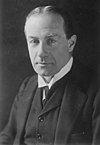
Second Baldwin ministry

Second Baldwin ministry | |
|---|---|
| 1924–1929 | |
 Stanley Baldwin (1920) | |
| Date formed | 4 November 1924 |
| Date dissolved | 4 June 1929 |
| People and organisations | |
| Monarch | George V |
| Prime Minister | Stanley Baldwin |
| Total no. of members | 114 appointments |
| Member party | Conservative Party |
| Status in legislature | Majority 412 / 615 (67%) |
| Opposition party | Labour Party |
| Opposition leaders |
|
| History | |
| Election | 1924 general election |
| Outgoing election | 1929 general election |
| Legislature terms | 34th UK Parliament |
| Predecessor | First MacDonald ministry |
| Successor | Second MacDonald ministry |
Stanley Baldwin of the Conservative Party formed the second Baldwin ministry upon his reappointment as Prime Minister of the United Kingdom by King George V after the 1924 general election. His second ministry ended following the so-called "Flapper Election" of May 1929.

Cabinet
November 1924 – June 1929
- Stanley Baldwin – Prime Minister and Leader of the House of Commons
- The Viscount Cave – Lord High Chancellor of Great Britain
- The Marquess Curzon of Kedleston – Leader of the House of Lords and Lord President of the Council
- The Marquess of Salisbury – Lord Keeper of the Privy Seal
- Winston Churchill – Chancellor of the Exchequer
- Sir William Joynson-Hicks – Secretary of State for the Home Department
- Sir Austen Chamberlain – Secretary of State for Foreign Affairs and Deputy Leader of the House of Commons
- Leo Amery – Secretary of State for the Colonies
- Sir Laming Worthington-Evans – Secretary of State for War
- The Earl of Birkenhead – Secretary of State for India
- Sir Samuel Hoare – Secretary of State for Air
- Sir John Gilmour – Secretary for Scotland
- William Clive Bridgeman – First Lord of the Admiralty
- The Viscount Cecil of Chelwood – Chancellor of the Duchy of Lancaster
- Sir Philip Cunliffe-Lister – President of the Board of Trade
- Edward Frederick Lindley Wood – Minister of Agriculture
- Lord Eustace Percy – President of the Board of Education
- The Viscount Peel – First Commissioner of Works
- Sir Arthur Steel-Maitland – Minister of Labour
- Neville Chamberlain – Minister of Health
- Sir Douglas Hogg – Attorney-General for England and Wales
Changes
- April 1925 – On Curzon's death, Lord Balfour succeeded him as Lord President. Lord Salisbury became the new Leader of the House of Lords, remaining also Lord Privy Seal.
- June 1925 – The post of Secretary of State for Dominion Affairs was created, held by Leo Amery in tandem with Secretary of State for the Colonies.
- November 1925 – Walter Guinness succeeded E.F.L. Wood as Minister of Agriculture.
- July 1926 – The post of Secretary of Scotland was upgraded to Secretary of State for Scotland.
- October 1927 – Lord Cushendun succeeded Lord Cecil of Chelwood as Chancellor of the Duchy of Lancaster
- March 1928 – Lord Hailsham (former Sir D. Hogg) succeeded Lord Cave as Lord Chancellor. Hailsham's successor as Attorney-General was not in the Cabinet.
- October 1928 – Lord Peel succeeded Lord Birkenhead as Secretary of State for India. Lord Londonderry succeeded Peel as First Commissioner of Public Works
List of ministers
Members of the Cabinet are in bold face.

- Notes
- ^ Created Viscount Hailsham 4 July 1929.
- ^ Also Leader of the House of Lords.
- ^ Also Leader of the House of Lords 27 April 1925 – 4 June 1929.
- ^ Created a Baronet 28 June 1928.
- ^ Knighted 1 December 1925.
- ^ Became Secretary of State for Scotland 15 July 1926.
- ^ Office abolished 26 July 1926.
- ^ Changed surname to Cunliffe-Lister 17 November 1924.
- ^ Created a Baronet 24 January 1927.
- ^ Created a Baronet 28 March 1929.
References
- D. Butler and G. Butler (ed.). Twentieth Century British Political Facts 1900–2000.
- ^ J C Sainty 'Assistant Whips 1922–1964' in Parliamentary History Vol 4 (1985) pp 201–04
See what we do next...
OR
By submitting your email or phone number, you're giving mschf permission to send you email and/or recurring marketing texts. Data rates may apply. Text stop to cancel, help for help.
Success: You're subscribed now !


